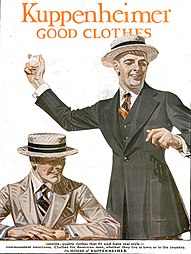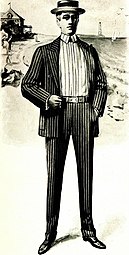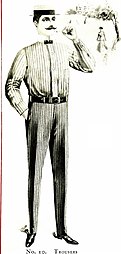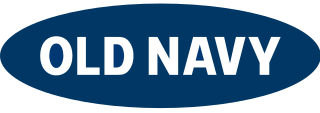
Old Navy is an American clothing and accessories retailing company owned by multinational corporation Gap Inc. It has corporate operations in the Mission Bay neighborhood of San Francisco, California. The largest of the Old Navy stores are its flagship stores, located in New York City, Seattle, Chicago, San Francisco, Manila, and Mexico City.
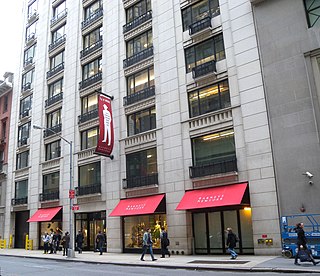
Barneys New York Inc. was an American luxury department store brand founded in New York City in 1923. It introduced major luxury brands including Armani, Azzedine Alaïa, Comme des Garçons, Christian Louboutin, and Ermenegildo Zegna to the US market.

Joseph Christian Leyendecker was a German-American illustrator, considered one of the preeminent American illustrators of the early 20th century. He is best known for his poster, book and advertising illustrations, the trade character known as The Arrow Collar Man, and his numerous covers for The Saturday Evening Post. Between 1896 and 1950, he painted more than 400 magazine covers. During the Golden Age of American Illustration, for The Saturday Evening Post alone, he produced 322 covers, and many advertisement illustrations for its interior pages. No other artist, until the arrival of Norman Rockwell two decades later, was so solidly identified with one publication. He "virtually invented the whole idea of modern magazine design."
George Zimmer is an American businessman. He is the founder, former executive chairman (1973–2013) and former CEO (1973–2011) of the Men's Wearhouse, a clothing retailer with more than 1,200 stores in the US and Canada, under the brands Moores, Men's Wearhouse and K&G Superstores. After leaving his executive position with the company, he continued as the company's spokesperson, until he was fired in June 2013. Zimmer is now the founder, chairman, and CEO and of Generation Tux, an online tuxedo and suit rental platform, and zTailors, a national network of on-demand tailors for men and women.

Tailored Brands, Inc. is an American retail holding company for various men's apparel stores, including the Men's Wearhouse and Jos. A. Bank brands. The company is headquartered in Houston, Texas, with additional corporate offices in Fremont, California.

Moores the Suit People, Inc., operating as Moores Clothing for Men, is a Canadian company specializing in business clothing and formalwear for men. It is an affiliate of Men's Wearhouse in the United States.

Hickey Freeman is a manufacturer of suits for men and boys, based in Rochester, New York, US, founded in 1899. The Hickey-Freeman Co. is the most distinguished of the once booming men's clothing industry based in Rochester at the start of the 20th century. Hickey Freeman tailored clothing continues to be made in the same storied Rochester facility opened in 1912.

Jos. A. Bank is an American retailer of men's furnishings, specializing in suits. Established in 1905 by Charles Bank and Joseph Alfred Bank. It operates about 200 retail locations, three distribution centers and seven tailoring centers. The company is headquartered in Fremont, California. Its parent company, Tailored Brands, also owns K&G Fashion Superstores, Men's Wearhouse, and Moores Clothing for Men in Canada.
Paul Stuart is a men's and women's luxury clothing brand founded in 1938 in New York City by haberdasher Ralph Ostrove (1898-1981), who named the company after his son, Paul Stuart Ostrove. The company has four standalone boutiques in the US, and two in Japan. Since 2012, it has been owned by Mitsui. The Paul Stuart logo is Dink Stover sitting on the Yale fence. Paul Stuart has been described as a blend of “Savile Row, Connecticut living and the concrete canyons of New York.” Its creative director is Ralph Auriemma.

Bond Clothing Stores, Bond Clothes, Bond Clothiers, or Bond Stores, was a men's clothing manufacturing company and retailer. The company catered to the middle-class consumer.
Caleres Inc. is an American footwear company that owns and operates a variety of footwear brands. Its headquarters is located in Clayton, Missouri, a suburb of St. Louis. Founded in 1878 as Bryan, Brown & Company in St. Louis, it underwent several name changes; for a time, the Hamilton-Brown Shoe Company was the largest manufacturer of shoes in America. It went bankrupt in June 1939.
Broadstreet's was a clothing business located at 576 - 578 Fifth Avenue (Manhattan). In August 1933 the firm leased the entire ground floor, mezzanine, and basement of a building at 5th Avenue and 47th Street, along with other stores in New York City. The lease was negotiated by the R.B. Wattley Company, Inc., and the Cross & Brown Company. The property extended 50 X 100 feet. Broadstreet's paid an estimated $50,000 per year for rent.

Mark's is a Canadian clothing and footwear retailer specializing in casual and industrial wear. Beginning in 1977 as Mark's Work Wearhouse in Calgary, Alberta, it evolved from an industrial accessories dealer to a men’s casual and industrial wear retailer. The company operates over 380 stores across Canada and has been a subsidiary of Canadian Tire since 2002.
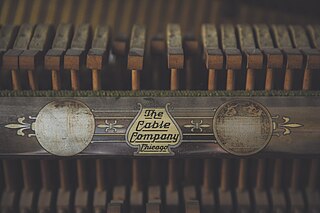
The Cable Company was an American manufacturer and distributor of pianos and reed organs that operated independently from 1880 to 1936.
Ralph Lauren Corporation is an American publicly traded fashion company that was founded in 1967 by American fashion designer Ralph Lauren. The company is headquartered in New York City, and it produces products ranging from the mid-range to the luxury segments. They are known for the marketing and distribution of products in four categories: apparel, home, accessories, and fragrances. The company's brands include the mid-range Chaps brand, to the sub-premium Lauren Ralph Lauren brand, to the premium Polo Ralph Lauren, Double RL, Ralph Lauren Childrenswear, and Denim & Supply Ralph Lauren brands, up to the full luxury Ralph Lauren Purple Label and Ralph Lauren Collection brands.

The Traffic Motor Truck Corporation (TMTC) was a St. Louis truck manufacturer from 1917 to 1929. It used Continental engines chiefly, and sometimes Gray Victory engines. The company was based at 5200 North Second Street. Guy C. Wilson was TMTC's president and Theodore C. Brandle was its vice president. Stephen W. Avery was the company's advertising manager.

Society Brand Clothes was a leading manufacturer of men's suits, based in Chicago. The company was founded in 1902 by Alfred Decker and Abraham Cohn. The company incorporated in 1919. It was known for its Society Brand line of suits and came to do business under the name Society Brand Clothes.

Anderson–Little was an American clothing manufacturer and retailer of the 20th century, particularly of men's suits. It operated in the eastern United States, and in New England in particular.

Moses Bensinger was an American merchant and manufacturer. He was president of the Brunswick-Balke-Collender Company from 1890 until his death in 1904. He was the instigator and organizer of the conglomerate of the manufacturer of billiard and pool tables when it was initially formed in 1884. The manufacture of bowling equipment as an additional business came about in 1888.
C&R Clothiers was a large chain of men's suit and furnishings stores based in Culver City, California. As of 1990 it had 67 stores across California. The chain dates back to 1948.


